Mechanical and Durability Assessment of Recycled Waste Plastic (Resin8 & PET) Eco-Aggregate Concrete
Abstract
:1. Introduction
2. Materials and Methods
2.1. Materials
2.2. Production of Resin8 RPW
2.3. Concrete Mix Design
3. Experimental Tests
3.1. Workability of Mixes
3.2. Strength Tests
3.2.1. Compressive Strength
3.2.2. Splitting Tensile Strength
3.3. Durability Tests
3.3.1. Oxygen Permeability Index
3.3.2. Effect of Temperature
3.4. Scanning Electron Microscopy (SEM)
4. Results and Discussion
4.1. Workability of Mixes
4.2. Strength Tests
4.2.1. Compressive Strength
4.2.2. Splitting Tensile Strength
4.2.3. Relationship between Compressive and Splitting Tensile Strength
4.3. Durability Tests—Oxygen Permeability Index (OPI)
4.4. Effect of Temperature on Compressive Strength
4.5. SEM Analysis
5. Conclusions
- Increasing the plastic content in the mix improves the workability of the concrete. Resin8 was less workable than PET, as the PET concrete slumped gradually, whereas the Resin8 concrete declined rapidly.
- A decrease in density and compressive strength were observed generally. Compressive strength increased with PET replacement content of 5% and 10% but decreased with PET replacement content of 15%. PET at a 10% replacement content increased the compressive strength of the mix by 2.5%, while Resin8 at a 5% replacement content decreased it by 4%.
- Splitting strength for all mixes decreased as the plastic content increased. PET concrete showed better strength at 10% and 15% than Resin8 at 5%.
- The plastic concrete’s OPI results indicated that the optimum replacement content for Resin8 and PET was 15%, indicating that all mixes are “good”. PET increased the OPI by 1.5% more than the reference mix.
- An almost negligible reduction in compressive strength of concrete containing Resin8 and PET after exposure to 250 °C has been observed. This behavior could be attributed to the healing of microcracks and filling of the large capillary pores (i.e., lowering the permeability and porosity) induced by sticking melted plastic to the coarse aggregate and cement paste and the possible formation of new portlandite and C-S-H gels caused by the rehydration of dehydrated products.
Author Contributions
Funding
Institutional Review Board Statement
Informed Consent Statement
Data Availability Statement
Acknowledgments
Conflicts of Interest
References
- Ncube, L.K.; Ude, A.U.; Ogunmuyiwa, E.N.; Zulkifli, R.; Beas, I.N. An overview of plastic waste generation and management in food packaging industries. Recycling 2021, 6, 12. [Google Scholar] [CrossRef]
- Pablo Ojeda, J. A meta-analysis on the use of plastic waste as fibers and aggregates in concrete composites. Const. Build. Mater. 2021, 295, 123420. [Google Scholar] [CrossRef]
- Singh, N.; Hui, D.; Singh, R.; Ahuja, I.P.S.; Feo, L.; Fraternali, F. Recycling of plastic solid waste: A state of art review and future applications. Comp. Part B Eng. 2017, 115, 409–422. [Google Scholar] [CrossRef]
- WWF Australia. Plastic Waste and Climate Change—What’s the Connection? Available online: https://www.Wwf.Org.Au/News/Blogs/Plastic-Waste-and-Climate-Change-Whats-the-Connection# (accessed on 16 February 2022).
- Al-Mansour, A.; Chen, S.; Xu, C.; Peng, Y.; Wang, J.; Ruan, S.; Zeng, Q. Sustainable cement mortar with recycled plastics enabled by the matrix-aggregate compatibility improvement. Const. Build. Mater. 2022, 318, 125994. [Google Scholar] [CrossRef]
- Thiounn, T.; Smith, R.C. Advances and approaches for chemical recycling of plastic waste. J. Poly. Sci. 2020, 58, 1347–1364. [Google Scholar] [CrossRef] [Green Version]
- Roy, P.S.; Garnier, G.; Allais, F.; Saito, K. Strategic Approach Towards Plastic Waste Valorization: Challenges and Promising Chemical Upcycling Possibilities. Chem. Sus. Chem. 2021, 14, 4007–4027. [Google Scholar] [CrossRef]
- Davidson, M.G.; Furlong, R.A.; McManus, M.C. Developments in the life cycle assessment of chemical recycling of plastic waste—A review. J. Clean. Prod. 2021, 293, 126163. [Google Scholar] [CrossRef]
- Steyn, Z.C.; Babafemi, A.J.; Fataar, H.; Combrinck, R. Concrete containing waste recycled glass, plastic and rubber as sand replacement. Const. Build. Mater. 2020, 269, 121242. [Google Scholar] [CrossRef]
- Schyns, Z.O.G.; Shaver, M.P. Mechanical Recycling of Packaging Plastics: A Review. Macromol. Rapid Comm. 2021, 42, 2000415. [Google Scholar] [CrossRef]
- Faraca, G.; Astrup, T. Plastic waste from recycling centres: Characterisation and evaluation of plastic recyclability. Waste Mgt. 2019, 95, 388–398. [Google Scholar] [CrossRef]
- CRDC Global. Resin8—The Concrete Solution to Plastic Waste, Ireland. 2020; Unpublished work. [Google Scholar]
- Babafemi, A.J.; Šavija, B.; Paul, S.C.; Anggraini, V. Engineering properties of concrete with waste recycled plastic: A review. Sustainability 2018, 10, 3875. [Google Scholar] [CrossRef] [Green Version]
- Mehta, P.K.; Monteiro, P.J.M. Concrete: Microstructure, Properties, and Materials, 4th ed.; McGraw-Hill Education: New York, NY, USA, 2014. [Google Scholar]
- Alexander, M. Fulton’s Concrete Technology, 10th ed.; Cement & Concrete, SA: Midrand, South Africa, 2021. [Google Scholar]
- Almeshal, I.; Tayeh, B.A.; Alyousef, R.; Alabduljabbar, H.; Mustafa Mohamed, A.; Alaskar, A. Use of recycled plastic as fine aggregate in cementitious composites: A review. Const. Build. Mater. 2020, 253, 119146. [Google Scholar] [CrossRef]
- Rathore, R.S.; Chouhan, H.S.; Prakash, D. Influence of plastic waste on the performance of mortar and concrete: A review. Mater. Today Proc. 2021, 47, 4708–4711. [Google Scholar] [CrossRef]
- Górak, P.; Postawa, P.; Natalia Trusilewicz, L.; Łagosz, A. Lightweight PET-based composite aggregates in Portland cement materials—Microstructure and physicochemical performance. J. Build. Eng. 2021, 34, 101882. [Google Scholar] [CrossRef]
- Kaur, G.; Pavia, S. Durability of mortars made with recycled plastic aggregates: Resistance to frost action, salt crystallisation, and cyclic thermal-moisture variations. J. Mater. Civil Eng. 2021, 33, 04020450. [Google Scholar] [CrossRef]
- Choi, Y.W.; Moon, D.J.; Kim, Y.J.; Lachemi, M. Characteristics of mortar and concrete containing fine aggregate manufactured from recycled waste polyethylene terephthalate bottles. Const. Build. Mater. 2009, 23, 2829–2835. [Google Scholar] [CrossRef]
- Mohammadhosseini, H.; Alrshoudi, F.; Tahir, M.M.; Alyousef, R.; Alghamdi, H.; Alharbi, Y.R.; Alsaif, A. Durability and thermal properties of prepacked aggregate concrete reinforced with waste polypropylene fibers. J. Build. Eng. 2020, 32, 101723. [Google Scholar] [CrossRef]
- Alrshoudi, F.; Mohammadhosseini, H.; Tahir, M.M.; Alyousef, R.; Alghamdi, H.; Alharbi, Y.; Alsaif, A. Drying shrinkage and creep properties of prepacked aggregate concrete reinforced with waste polypropylene fibers. J. Build. Eng. 2020, 32, 101522. [Google Scholar] [CrossRef]
- Borg, R.P.; Baldacchino, O.; Ferrara, L. Early age performance and mechanical characteristics of recycled PET fibre reinforced concrete. Const. Build. Mater. 2016, 108, 29–47. [Google Scholar] [CrossRef] [Green Version]
- Thorneycroft, J.; Orr, J.; Savoikar, P.; Ball, R.J. Performance of structural concrete with recycled plastic waste as a partial replacement for sand. Const. Build. Mater. 2018, 161, 63–69. [Google Scholar] [CrossRef]
- Harihanandh, M.; Karthik, P. Feasibility study of recycled plastic waste as fine aggregates in concrete. Mater. Today Proc. 2022, 52, 1807–1811. [Google Scholar] [CrossRef]
- Saikia, N.; de Brito, J. Mechanical properties and abrasion behaviour of concrete containing shredded PET bottle waste as a partial substitution of natural aggregate. Constr. Build. Mater. 2014, 52, 236–244. [Google Scholar] [CrossRef]
- Al-Manaseer, A.A.; Dalal, T.R. Concrete containing plastic aggregates. Concr. Int. 1997, 19, 47–52. [Google Scholar]
- Ullah, K.; Qureshi, M.I.; Ahmad, A.; Ullah, Z. Substitution potential of plastic fine aggregate in concrete for sustainable production. Structures 2022, 35, 622–637. [Google Scholar] [CrossRef]
- Ahmad, F.; Jamal, A.; Mazher, K.M.; Umer, W.; Iqbal, M. Performance evaluation of plastic concrete modified with e-waste plastic as a partial replacement of coarse aggregate. Materials 2022, 15, 175. [Google Scholar] [CrossRef]
- Correia, J.R.; Lima, J.S.; de Brito, J. Post-fire mechanical performance of concrete made with selected plastic waste aggregates. Cem. Conc. Comp. 2014, 53, 187–199. [Google Scholar] [CrossRef]
- BS EN 12350-2; Testing Fresh Concrete—Slump Test. British Standards Institution: London, UK, 2009.
- BS EN 1239:3; Testing Hardened Concrete Compressive Strength of Test Specimens. British Standards Institution: London, UK, 2019.
- BS EN 12390-6; Testing Hardened Concrete Tensile Splitting Strength of Test Specimens. British Standards Institution: London, UK, 2009.
- SANS 3001-CO3-2; Concrete Durability Index Testing—Oxygen Permeability Test. South African Bureau of Standards: Pretoria, South Africa, 2015.
- Belmokaddem, M.; Mahi, A.; Senhadji, Y.; Pekmezci, B.Y. Mechanical and physical properties and morphology of concrete containing plastic waste as aggregate. Constr. Build. Mater. 2020, 257, 119559. [Google Scholar] [CrossRef]
- Mustafa, M.A.T.; Hanafi, I.; Mahmoud, R.; Tayeh, B.A. Effect of partial replacement of sand by plastic waste on impact resistance of concrete: Experiment and simulation. Structures 2019, 20, 519–526. [Google Scholar] [CrossRef]
- Kangavar, M.E.; Lokuge, W.; Manalo, A.; Karunasena, W.; Frigione, M. Investigation on the properties of concrete with recycled polyethylene terephthalate (PET) granules as fine aggregate replacement. Case Stud. Const. Mater. 2022, 16, e00934. [Google Scholar] [CrossRef]
- Githachuri, K.; Alexander, M.G. Durability performance potential and strength of blended Portland limestone cement concrete. Cem. Conc. Comp. 2013, 39, 115–121. [Google Scholar] [CrossRef]
- Miah, M.J.; Kallel, H.; Carré, H.; Pimienta, P.; La Borderie, C. The effect of compressive loading on the residual gas permeability of concrete. Constr. Build. Mater. 2019, 217, 12–19. [Google Scholar] [CrossRef]
- Miah, M.J. The Effect of Compressive Loading and Cement Type on the Fire Spalling Behaviour of Concrete. Ph.D. Thesis, Université de Pau et des Pays de l’Adour, Pau, France, 19 October 2017. [Google Scholar]
- Alfahdawi, I.H.; Osman, S.A.; Hamid, R.; AL-Hadithi, A.I. Influence of PET wastes on the environment and high strength concrete properties exposed to high temperatures. Constr. Build. Mater. 2019, 225, 358–370. [Google Scholar] [CrossRef]
- Choudhary, R.; Kumar, A.; Murkute, K. Properties of Waste Polyethylene Terephthalate (PET) Modified Asphalt Mixes: Dependence on PET Size, PET Content, and Mixing Process. Period. Polytech. Civ. Eng. 2018, 62, 685–693. [Google Scholar] [CrossRef]
- Li, Y. Effect of post-fire curing and silica fume on permeability of ultra-high-performance concrete. Constr. Build. Mater. 2021, 290, 123175. [Google Scholar] [CrossRef]
- Owens, G. Fundamentals of Concrete, 3rd ed.; The Concrete Institute: Midrand, South Africa, 2013. [Google Scholar]
- Wu, K.; Shi, H.; Xu, L.; Ye, G.; de Schutter, G. Microstructural characterisation of ITZ in blended cement concretes and its relation to transport properties. Cem. Conc. Res. 2016, 79, 243–256. [Google Scholar] [CrossRef]
- Lee, Z.H.; Paul, S.C.; Kong, S.Y.; Susilawati, S.; Yang, X. Modification of waste aggregate PET for improving the concrete properties. Adv. Civil Eng. 2019, 2019, 6942052. [Google Scholar] [CrossRef]
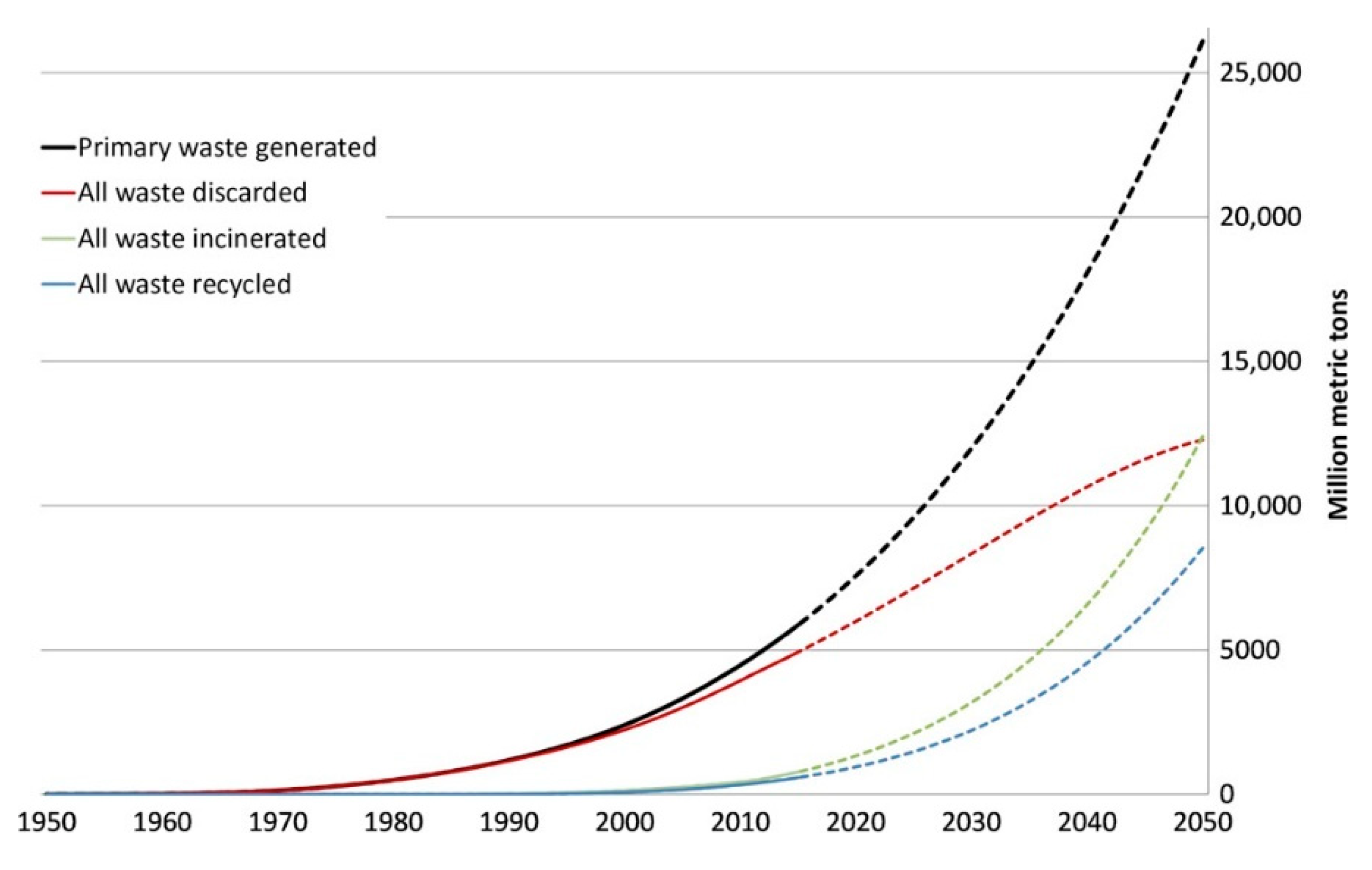

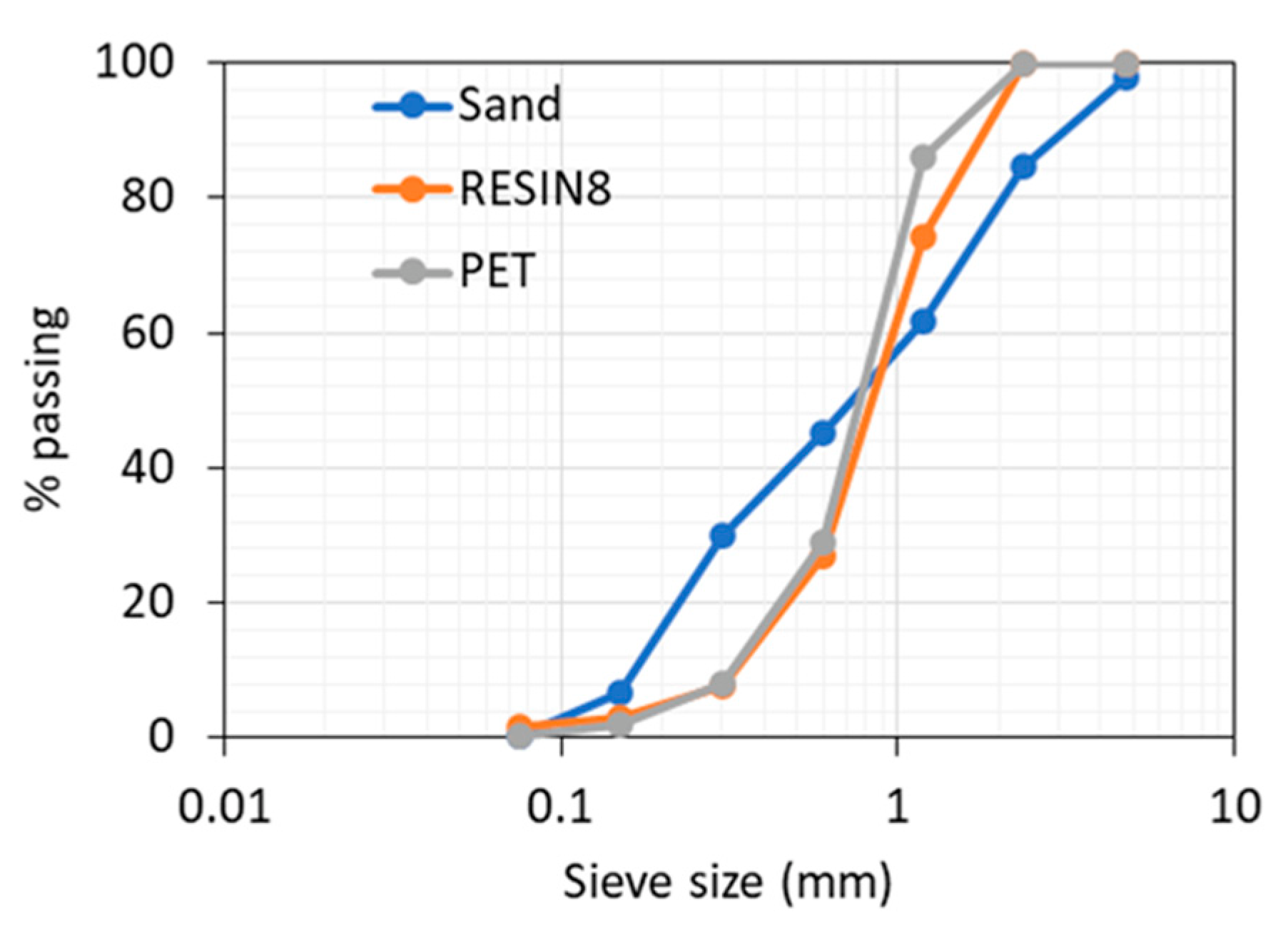

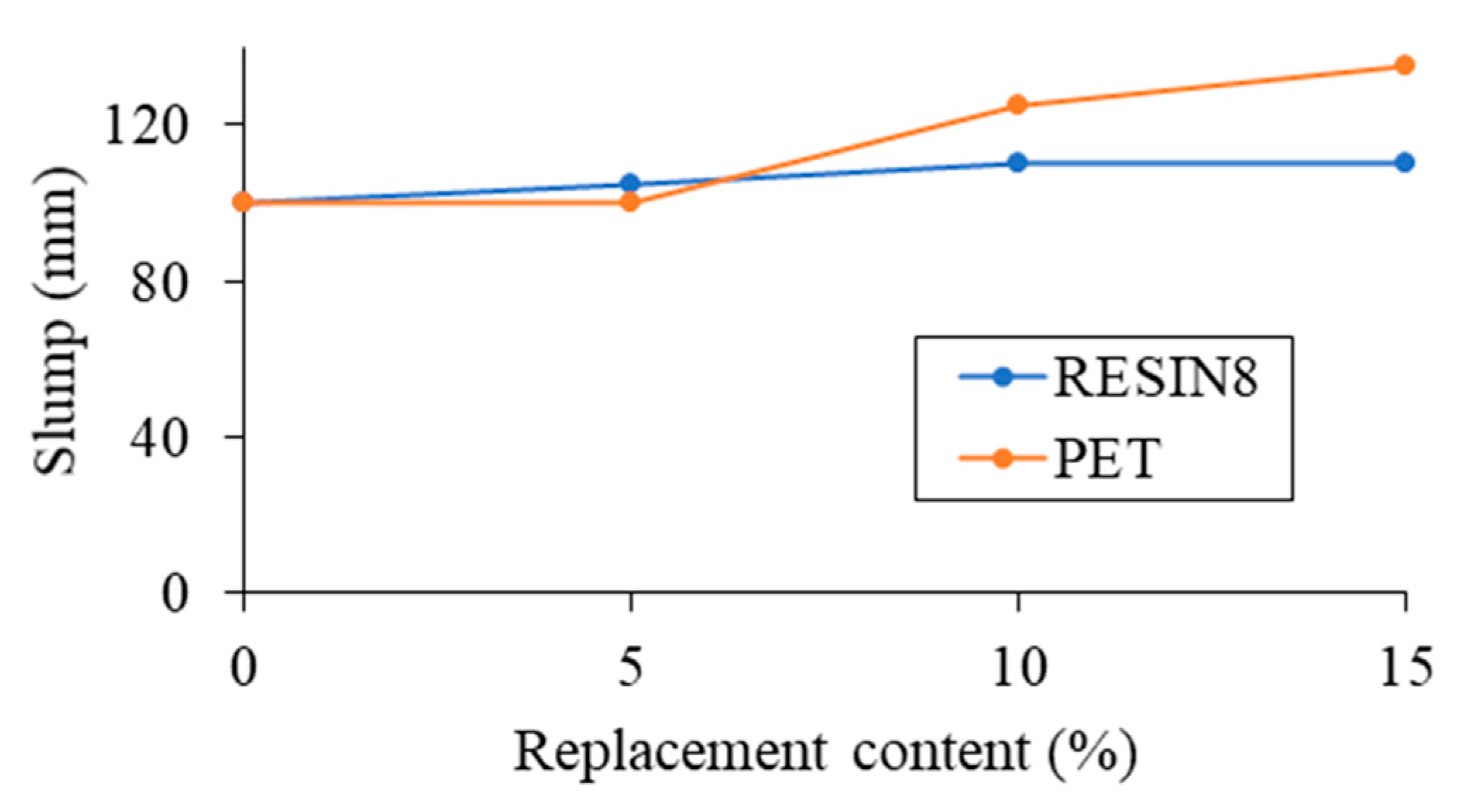
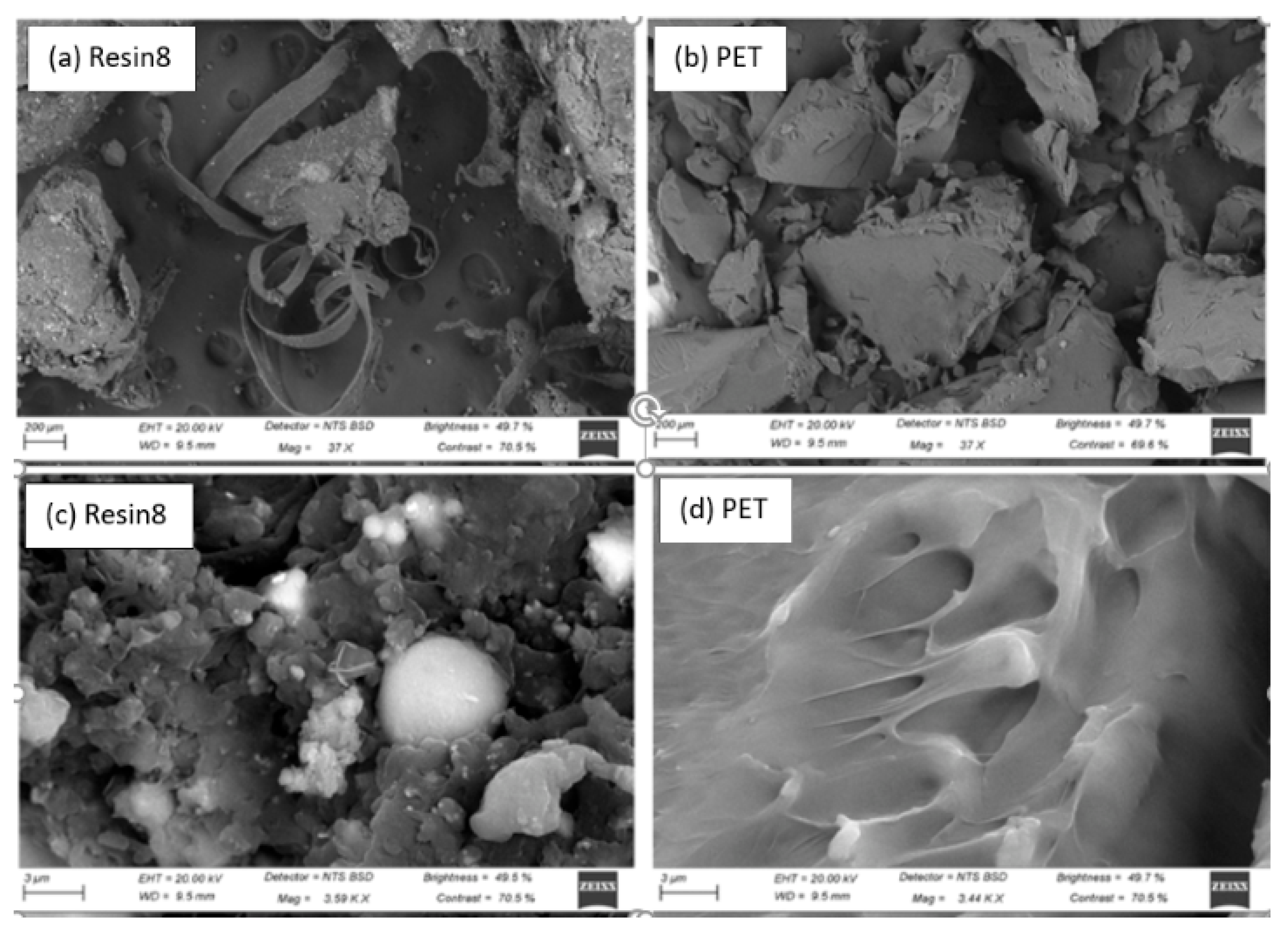

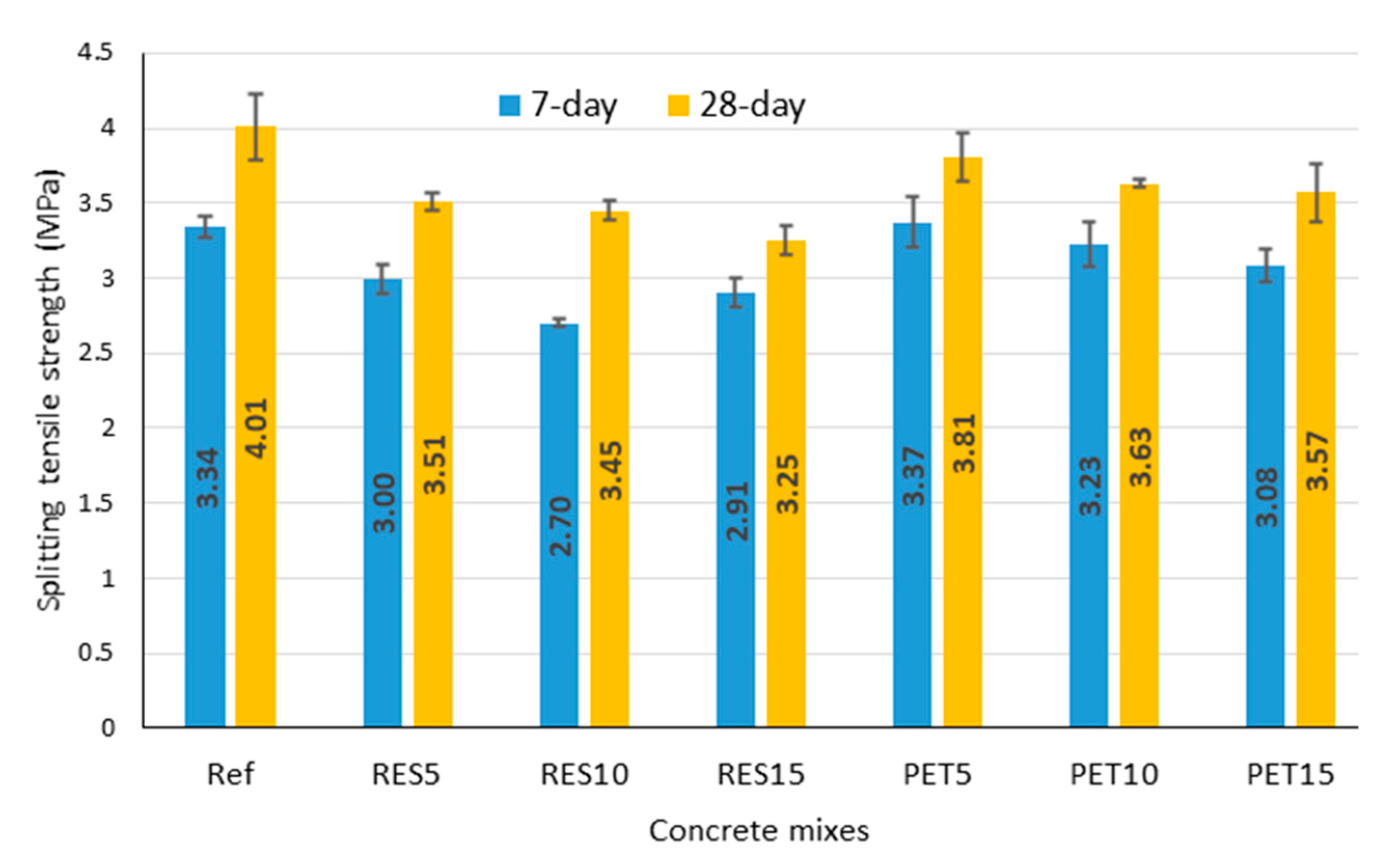

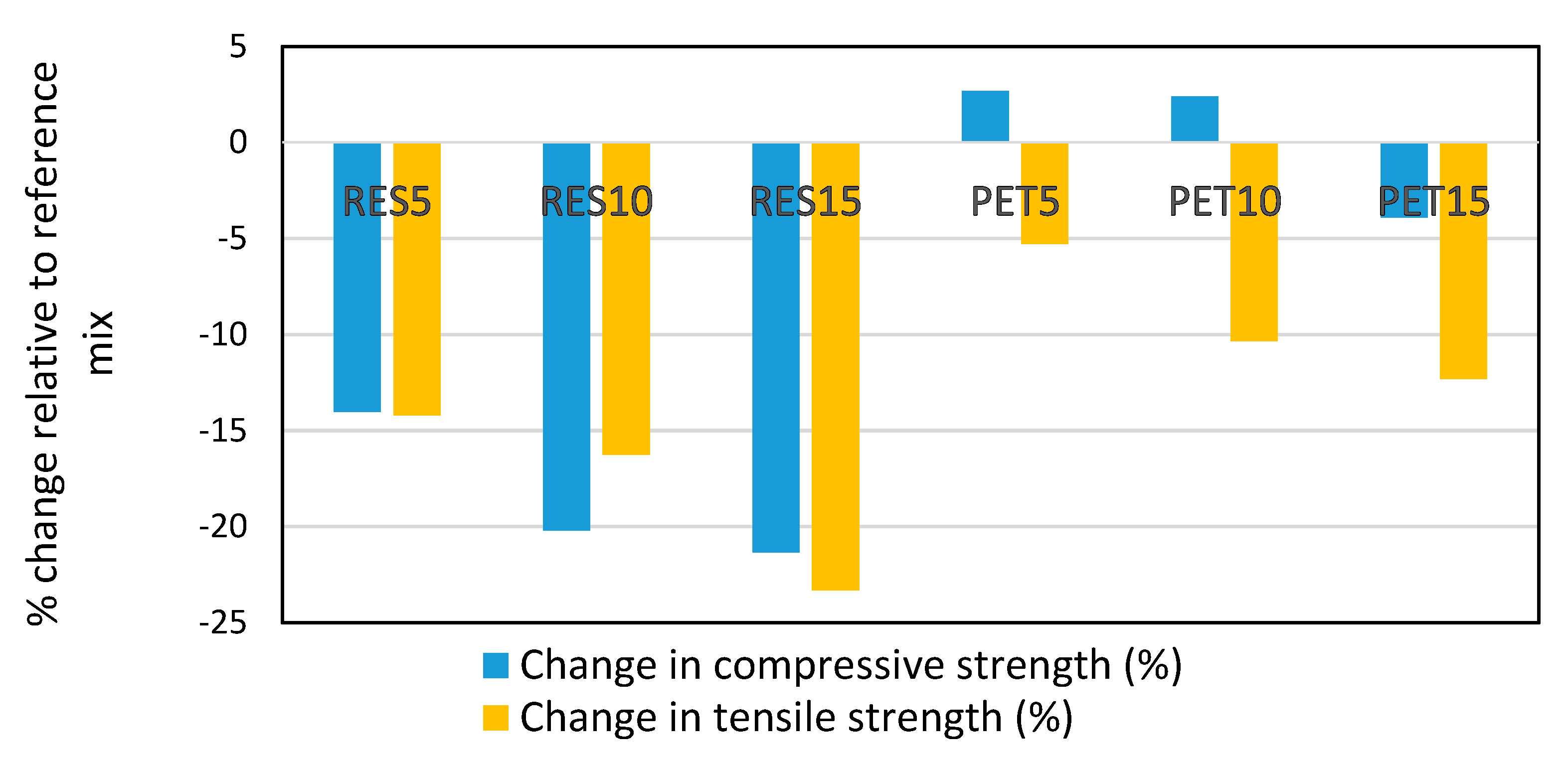
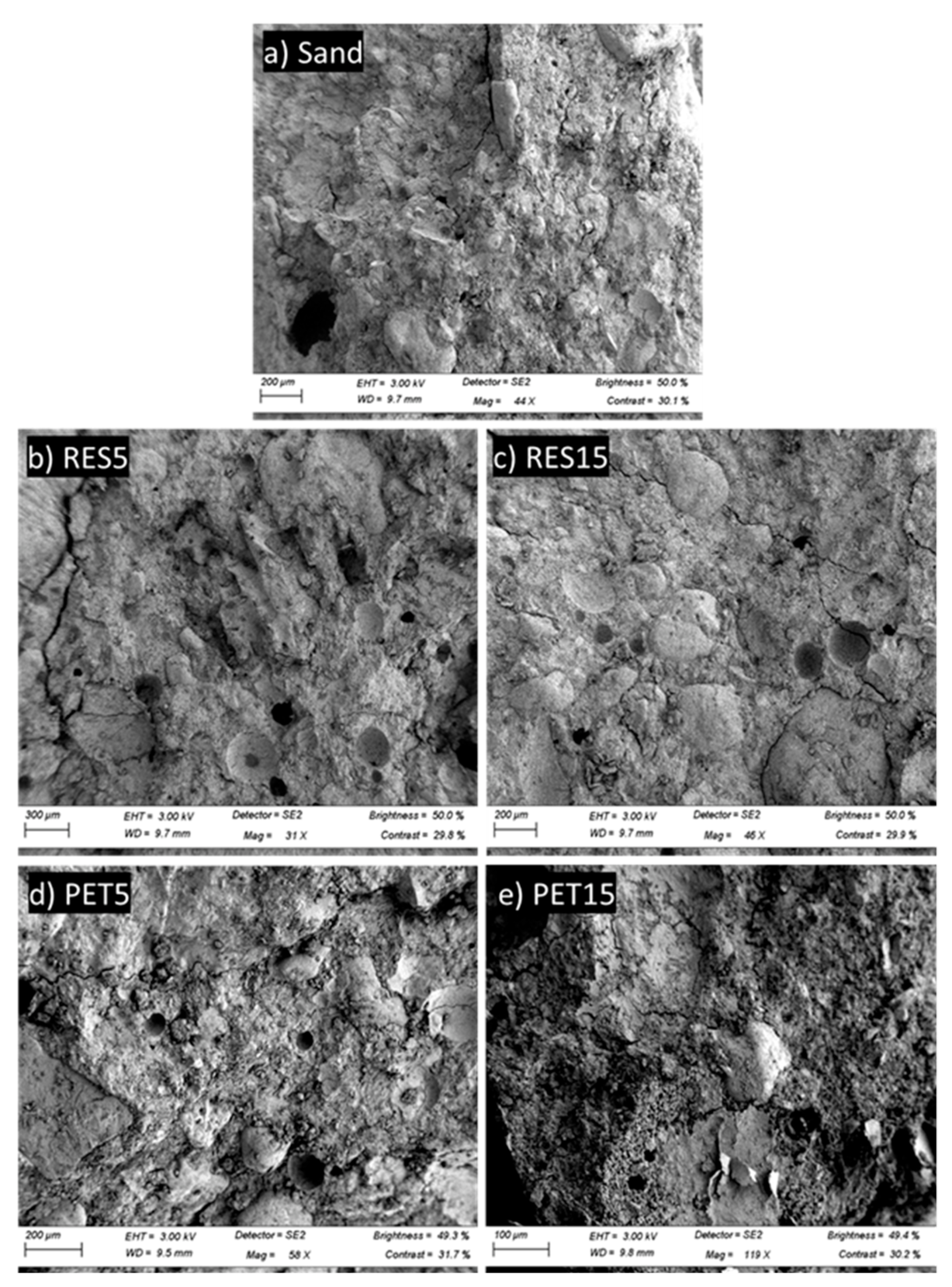

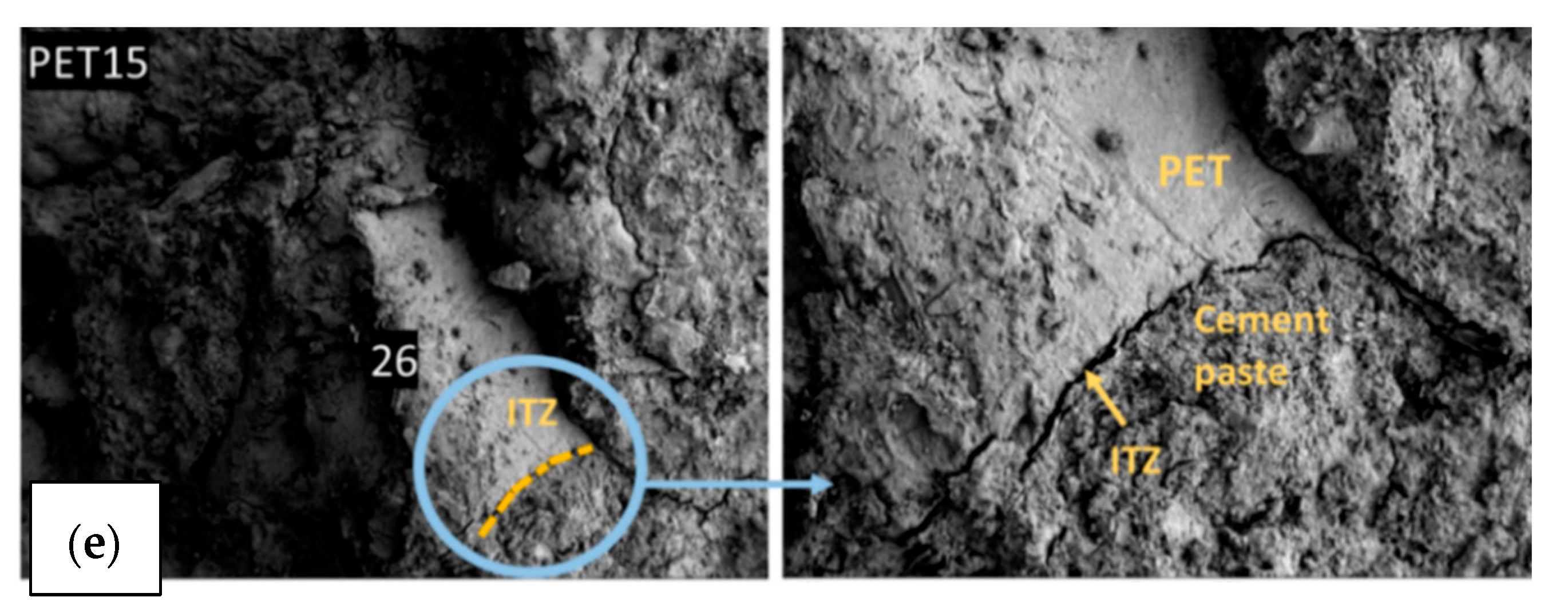
| Mix ID | Sand (kg/m3) | Plastic (kg/m3) | Stone (kg/m3) | Cement (kg/m3) | Water (kg/m3) |
|---|---|---|---|---|---|
| Ref | 758 | 0 | 940 | 450 | 225 |
| RES5 | 720 | 14 | 940 | 450 | 225 |
| RES10 | 682 | 28 | 940 | 450 | 225 |
| RES15 | 645 | 42 | 940 | 450 | 225 |
| PET5 | 720 | 21 | 940 | 450 | 225 |
| PET10 | 682 | 42 | 940 | 450 | 225 |
| PET15 | 645 | 63 | 940 | 450 | 225 |
| Mixes | OPI (log Scale) | k (1011) m/s |
|---|---|---|
| Ref | 10.36 | 4.81 |
| RES5 | 10.16 | 7.06 |
| RES10 | 10.04 | 9.11 |
| RES15 | 9.98 | 11.10 |
| PET5 | 10.48 | 3.33 |
| PET10 | 10.35 | 5.17 |
| PET15 | 10.27 | 5.35 |
| Mixes | Compressive Strength (MPa) | |
|---|---|---|
| Pre-Temperature | Post-Temperature | |
| RES15 | 29.98 | 28.87 |
| PET5 | 37.37 | 37.94 |
| PET10 | 37.27 | 37.16 |
| PET15 | 35.00 | 35.62 |
Publisher’s Note: MDPI stays neutral with regard to jurisdictional claims in published maps and institutional affiliations. |
© 2022 by the authors. Licensee MDPI, Basel, Switzerland. This article is an open access article distributed under the terms and conditions of the Creative Commons Attribution (CC BY) license (https://creativecommons.org/licenses/by/4.0/).
Share and Cite
Babafemi, A.J.; Sirba, N.; Paul, S.C.; Miah, M.J. Mechanical and Durability Assessment of Recycled Waste Plastic (Resin8 & PET) Eco-Aggregate Concrete. Sustainability 2022, 14, 5725. https://doi.org/10.3390/su14095725
Babafemi AJ, Sirba N, Paul SC, Miah MJ. Mechanical and Durability Assessment of Recycled Waste Plastic (Resin8 & PET) Eco-Aggregate Concrete. Sustainability. 2022; 14(9):5725. https://doi.org/10.3390/su14095725
Chicago/Turabian StyleBabafemi, Adewumi John, Nina Sirba, Suvash Chandra Paul, and Md Jihad Miah. 2022. "Mechanical and Durability Assessment of Recycled Waste Plastic (Resin8 & PET) Eco-Aggregate Concrete" Sustainability 14, no. 9: 5725. https://doi.org/10.3390/su14095725
APA StyleBabafemi, A. J., Sirba, N., Paul, S. C., & Miah, M. J. (2022). Mechanical and Durability Assessment of Recycled Waste Plastic (Resin8 & PET) Eco-Aggregate Concrete. Sustainability, 14(9), 5725. https://doi.org/10.3390/su14095725









